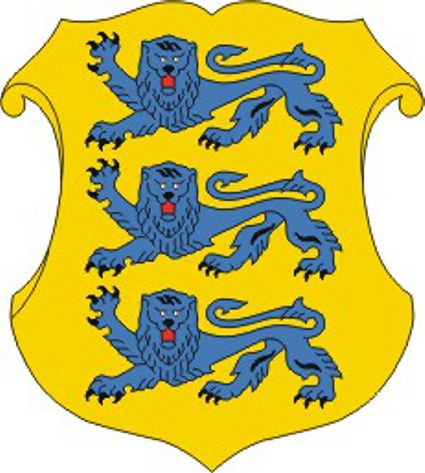 The arms of Estonia
The arms of Estonia
The lions in the Royal Arms of England came onto the heraldic scene some eight hundred years ago – but from where, and why, remains obscure. The creatures, -three lions passant guardant – are truly striking and unusual and were no doubt particularly so when they first appeared,1 gold and in pale on the king’s red shield.
Considering the eminent scholars who have researched the history of the arms, but who have not yet fully solved the mystery of exactly when the lions were adopted it might seem presumptuous for a foreigner such as myself to attempt to present a theory about their origin. However, as an excuse, I can offer a personal interest because my home town is Brunswick, moment as in England. Otto IV, German King and Emperor of the Romans, arms comprising the Empire, dimidiating England, (or vice versa, both versions are known). In the version with the black eagle on gold on the dexter the lions on the sinister are shown in full, whereas in the other version, where the reverse applies, their front quarters only appear. Because Otto also bore the plain imperial eagle, the dimidiated arms were personal to him. He was the first, and in fact the only German Emperor to bear dimidiated arms. They aroused a lot of attention and also criticism by his contemporaries who regarded it as unfitting for the Emperor to cut the imperial bird in half, and, precedence.2
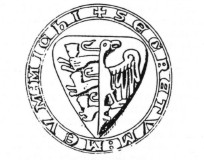 Arms of Emperor Otto IV (r. 1198-1218)
Arms of Emperor Otto IV (r. 1198-1218)
That Otto did not care more about heraldic protocol and about the feelings of his subjects, was due both to his upbringing and his descent. He was more Anglo-Norman that German, having been raised in England where his father, Henry the Lion, erstwhile Duke of Saxony and Bavaria, lived in exile after forfeiting his territories by his opposition to Emperor Frederick the Redbeard. Otto, a grandson of King Henry II of England through Henry’s daughter Mathilda, who had married Henry the Lion, was the favourite nephew of King Richard I, who oversaw his knightly education and bestowed high favours on him. The young man, being unusually tall for his time, excelled in the martial arts to the delight of Richard the Lionheart, whom fate had denied him.
In 1196 Richard created Otto Count of Poitou and Duke of Aquitaine, tantamount to Viceroy, of the English possessions in France with the exception of Normandy (which Richard retained for himself). Presumably, the King assigned arms to Otto on that occasion, and indeed a seal (1197) of Otto as Count of Poitou has survived.3 It is tantalising, however, that his arms are not visible, because we see Otto, on horseback, riding from left to right displaying only the back of his shield.4 Considering the fondness of Richard for his nephew he may even have planned to make Otto his successor on the English throne 5 because he was averse to his brother John or, eventually, of John’s offspring succeeding him. In 1198, however, Otto was called into an even higher rank, being elected King of the Romans by the anti-Hohenstaufen party in Germany.
Just when exactly Otto adopted his Anglo-German arms is uncertain. The first pictorial evidence dates from 1209, but it is likely he has already employed the design c 1198, possibly in order to maintain a claim to the English throne. Indeed this may be the reason why he chose to combine the English lions with the Imperial eagle. Matthew Paris, who depicts Otto’s arms twice, reports that he assumed them at his coronation in 1198 “out of love for the King of England”. But even apart from his uncle’s predisposition towards him, as a grandson of Henry II Otto ranked high in the line of English succession.
Otto had an older brother, Henry, Count Palatine, who also bore lions passant, but in his case two not three 6 as is depicted on his seals dating from around 1196,7 and these arms later became those of the Duchy of Brunswick, and lasted until 1918. It is just possible that Otto himself may have borne two lions – and in later depictions of his German bearings he is indeed accorded two8 but this most probably reflects Brunswick’s local tradition rather than historical fact.
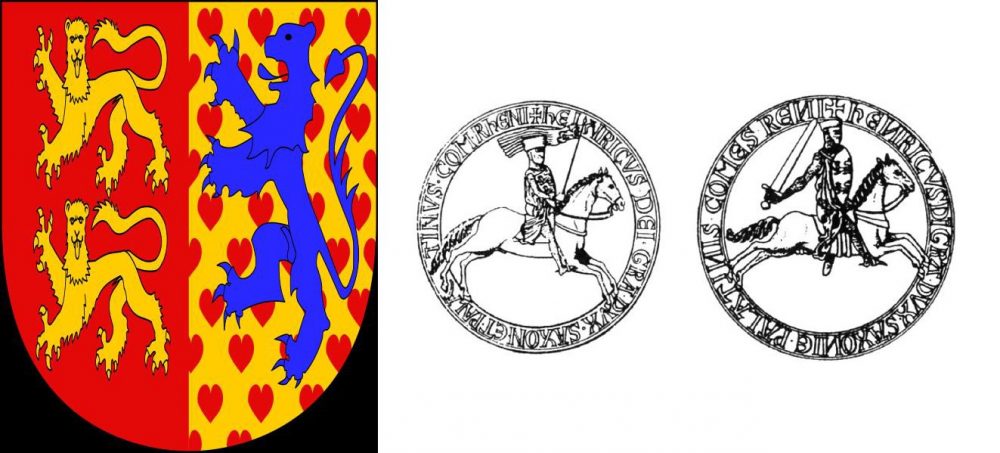 Arms of Brunswick Lüneberg with First (1196) and second (1209) seals of Henry Count Palatine
Arms of Brunswick Lüneberg with First (1196) and second (1209) seals of Henry Count Palatine
The German evidence indicates that by 1198 two versions of arms with lions passant guardant – one with three, one with two lions – were well established and existed simultaneously. Hence the question arises as to which was the senior version? Among British historians, conventional wisdom hold that the English Royal Arms developed in a seemingly natural way: one, two, three, which sounds reasonable, but in fact the evolution was quite complex.
The first King believed to have borne an armorial device, namely a single lion rampant, was Henry I, who reigned from 1100 to 1135, earlier royal arms being merely attributed. However, no arms of Henry I have come to light. Adrian Ailes, who has written the most exhaustive monograph 9 on the origins of the Royal Arms of England, takes it for granted that Henry II (1154-1189) bore either a single lion rampant, or two lions passant, (maybe guardant – in the early days little emphasis was put on such details), and perhaps even three lions passant guardant, and that he either changed his arms twice, or that he used two or three versions concurrently.10
A lot of important reasoning has been brought forward to support the alleged arms of Henry II,11 and certainly that monarch was aware of the symbolism of the lion in Arthurian and other legends and several of his relatives are known to have borne lion arms of some kind or other. But, as far as Henry II himself is concerned, unfortunately no arms of his have ever been found.12 Even given the varying survival rates of historical documents this is strange, The king certainly issued a great many grants and warrants so had he used an armorial seal, at least one or two impressions should have been preserved.
But the sad fact is that we lack any real proof of arms borne by Henry. It is often overlooked that heraldry, still rather new in his day did not spread from the top of the social ladder downwards, but from somewhere in the middle – from the landed gentry and the military, both downwards and upwards. High personages like kings or emperors assumed arms only relatively late.13 Only when heraldry gained wide popularity did it become unthinkable that a noble person should not possess arms and hence legendary heroes like King David or Alexander the Great, and even the three wise men, Jesus Christ, and Death, were attributed coats of arms. Only in and after the late 12th century, several decades after the birth of heraldry did sovereigns begin to identify themselves by heraldic display.
The first English king who can be proven to have borne arms is Richard I (1189-99). Two great seals of him still exist. On the first Richard bears a shield with a single lion rampant.
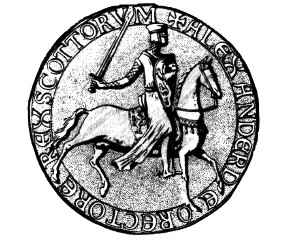 The first great seal of Richard I
The first great seal of Richard I
This was replaced by a new Great Seal, the matter is anything but simple. To start with, the date of adoption of the three lions by Richard is not quite certain. Although there is written testimony that he had a new seal made for him in 1195, he continued to use his first seal. Of his second seal, the first impression that has survived dates only from 1198.
It is strange that three years elapsed before we find any proof of Richard actually using his new seal – so accordingly, we cannot be quite sure whether the three lions seal was indeed the instrument of 1195. The matter is made more complicated because some British scholars believe that Richard also bore two lions combatant, based on the fact that on his first seal the lion rampant is facing sinister. But this must not be over interpreted. Other early seals exist showing beasts so facing,15 and it is always possible that the engraver chose to make the lion face as it did to symbolically defy enemies.
When further considering one lion rampant or three passant we must also bear in mind that in the 1190s the shield remained kite-shaped after the Norman style rather than heater-shaped style as was more popular later. Into such geometry a lion rampant fits nicely, as do three beasts passant in aesthetically pleasing fashion,16 but two lions passant do not – even appearing to “float” surrounded by empty space.
It seems reasonable to suggest that Richard’s younger brother John as Lord of Ireland and “son of the king of England”17 as styled on his seal, bore two lions because he was a junior member of the Plantagenet line and his cognisance represented, not an earlier stage in the development of the Royal arms, but an indication of lower station in the ruling family. Reverting to Richard I, it is reasonable to ask why he changed his lion rampant coat for the three in pale? Adrian Ailes pointed out one of the possible motives was very prosaic: Richard may have changed in order to raise money by invalidating all former charters sealed with his first great seal and requiring all owners to have their grants confirmed. Another good reason might have been one-upmanship as it were. Richard could have felt the need to top his brother’s coat. Relations between the two were strained, John had been a contender for the throne and thus had to be publicly reminded of his proper place, one step behind the monarch. Matthew Paris, in his Historia Minor Anglorum, compiled in 1250/53, offered a different explanation: the King of England bore three leopards because he is king, duke, and count. But Matthew also attributed to William the Conqueror, who lived a century before the dawn of heraldry.18 We may dismiss any notion that the three lions represented the territories of the Angevin empire: England, Normandy, and Aquitaine (or Anjou). Arms in those days were not yet territorial, but personal. And in any case the two-lion coat of Normandy was associated with that country only much later
It is well to keep in mind that King Richard spent most of his reign abroad. Where, then, could he have been inspired or in any other way have been induced to choose his unique coat of arms, the impressive three lions passant? In 1192 Richard was returning from the third crusade. On his way home he was captured by Duke Leopold of Austria whom he had gravely insulted in the Holy Land. The Duke turned him over to Emperor Henry VI and Richard swore an oath of fealty to his captor, so England was from now on, at least in theory, a fief of the Empire, or rather, along the lines of feudal society, Richard was now a vassal of his new liege lord, the Emperor. This was in no way dishonourable. Feudal relationships were personal and did not diminish the feudatory’s dignity, but it might have had a lasting impression on heraldry. Henry VI was a member of the Hohenstaufen family, who were also Dukes of Suabia, their home region. The arms of Suabia, most interestingly, underwent the same transition as the English arms. The first Dukes bore a single lion rampant until they exchanged it for three lions passant, black on a gold field. Black and gold in heraldry are a rare combination,
Of course, as in the case of the English lions, we may also ask: Why three lions passant? The answer seems obvious, just like Richard found it convenient to top everybody else’s arms in England, the Suabian Hohenstaufen, from whose ranks had come all German Kings and Emperors since 1138, wanted to stress their premier rank among all German princes with a non plus ultra coat.
It would be most natural for Richard to have been inspired by this arrangement to base his own along the same lines. But there could be even more to it, for when Henry VI released Richard, his new vassal, he might well have bestowed on him a variant of his own family coat of arms, but it is interesting to note that this would not have been an eagle coat. Several German princes bore such, clearly derived from the imperial bird. But, compared with Richard, they were lesser princes, rulers of marches on the outskirts of the Empire. Richard’s status was higher, even as a feudatory of the Emperor, who could not deceive himself into believing that he had added a new tributary state to his realm. He was well aware that their feudal relationship was personal. So he may have conferred on the king a variant not of his arms of dominion but, on a more personal note, of his family arms.
However I must admit to a time problem. As noted above, Richard’s three lions date from the 1190s. But then, so do the Suabian beasts – first seen on a seal of Duke Philip (around 1196-1198), two to four years after Richard had returned to England. The last Suabian ruler to display the single rampant animal was Konrad (d 1196), the last known instance being in 1192.19 But armorial ensigns were changed at will and it could well be that Duke Konrad adopted the three lions some time between 1192 and 1196.
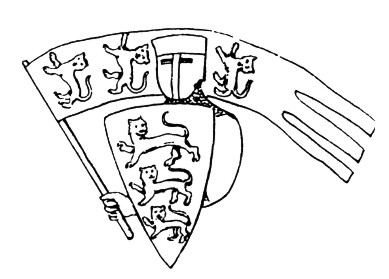 shield and banner of Henry duke of Swabia from his seal of 1216
shield and banner of Henry duke of Swabia from his seal of 1216
It is strange that, to my knowledge, no British scholars seem to have seriously considered the possibility of the lions of England having originated anywhere else but in England.20 But this may not be surprising, for when the study of history developed into a serious subject in the 19th century nationalism was taken for granted. Historians as well as heraldic scholars found it inconceivable that a symbol so truly English as Richard’s lions should not be of native origin. They are truly English, of course, but also European and there is another interesting case paralleling the Suabian and English lions: Denmark, whose arms are three lions passant guardant, blue on a gold field semee with what today are considered to be hearts but were originally water-lily leaves. They appeared c 1194 on the seal of King Canute VI. Then from Denmark they temporarily spread to Sweden, where King Erik XI (1222-1229, 1234-50) and King Waldemar (1250-1275) bore them
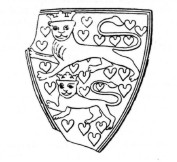 Arms of Eric Duke of Jutland (Slesvig), from his seal (1272)
Arms of Eric Duke of Jutland (Slesvig), from his seal (1272)
Most Danish scholars have denied any German connection with their royal arms,22 considering the often strained relations between the two countries, that is understandable. But again, such a connection would have been perfectly natural, because Denmark in the 11th and 12th centuries acknowledged the Emperor’s suzerainty over their country.
Interestingly, the English two lion version also has a parallel in Denmark. The Dukes of Slesvig, junior members of the Danish royal house, were given two azure lions on a gold field. These have survived as regional arms, Holstein. So, the “lion family” is alive and well in Europe, the Channel Islands, and the New World. The English beasts have migrated to Canada and Virginia,23 and have “fathered” offspring in Normandy, Guyenne, lions have reappeared in Estonia, having previously been suppressed by the Soviet overlords. The Suabian lions which were never quite forgotten, were resurrected in 1954, when the German state of Baden-Württemberg, which we may term “Suabia revived”, re-adopted them.
 Arms of Baden-Württemberg
Arms of Baden-Württemberg
Notes and References
- I shall not dwell here on possible different meanings regarding the terms “lions” and “leopards” in early heraldry.
- A full account of all known representations of Otto’s arms and other symbols of sovereignty is given by Bernd Ulrich Hucker: Kaiser Otto IV., Hannover 1990, pp. 558-602.
- François Eygun: Sigillographie du Poitou jusqu’en 1515, Macon 1938, p. 160, nr.7.
- Werner Paravicini: Die älteste Wappenrolle Europas: Ottos IV. Aachener Krönung von 1198;, : (Archivum Heraldicum CVII) 1993-11, pp. 99-146.
- Hucker, op. cit., p. 17, and other authors before him.
- Bernd Schneidmüller: “Die Siegel des Pfalzgrafen Heinrich bei Rhein, Herzogs von Sachsen (1195/96-1227)”;: Niedersächsisches Jahrbuch für Landesgeschichte, Vol.57, 1985, pp.257-265.
- The document depicting Henry’s two lions seal is preserved at the State Archives in Dresden (O.U. 113). Adrian Ailes (see note 9) states (p. 61) that Henry “seems to have been using the two lions shield” even before 1195, but the earliest actual proof is the document of 1196.
- On a 14th century glass window in a Brunswick church (Hucker, op. cit., fig. 14).
- Adrian Ailes: The Origins of the Royal Arms of England: Their Development to 1199,
- op. cit., p.62
- op. cit., pp. 54-63; Gerard J. Brault: Early Blazon, Oxford 1972, pp. 20-22.
- Nicholas Rogers (“The shrine of St. Mengold at Huy and its heraldic importance” The Coat of Arms, nr. 127, 1983, pp. 176-182) has brought to light an intriguing case of the three lions possibly appearing in the 1180’s or even 1170’s, i.e. as early as Henry II’s reign – if indeed the shrine were that old. The saint, an alleged son of a legendary English King Hugh, wears a surcoat with three heraldic lions passant guardant. However, the author himself admits that the heraldic elements of the shrine, when analyzed in regard to style, seem to have been finished considerably later, between 1200 and 1220.
- Ottfried Neubecker: “Die ideologische Funktion des Wappenschildes,”: Der Tappert,
- The French royal arms do not appear until 1223 (Louis VIII), although the kings of France made use of the fleur-de-lys in other ways much earlier. See Hervé Pinoteau: Héraldique capétienne, Paris 1979, p. 3.
- Examples are given by Ailes, op. cit., p. 69
- When heraldists study arms, they are chiefly concerned with their symbolism and supposed meanings, whereas they tend to neglect more practical and down-to-earth aspects, Reflections on the Art and Science of Heraldry;” Genealogica & Heraldica, Lisbon 1986, pp. 495-503.
- Although an early theory that he used this seal already in 1177 has been discarded, he may have used it since 1185, when he was 18 and knighted by his father. See Adrian Ailes: “The seal of John, Lord of Ireland and Count of Mortain;” The Coat of Arms, N.S. vol. IV, nr. 117, 1981, pp.341-350.
- See Felix Hauptmann “Die Wappen in der Historia minor des Matthäus Parisiensis”: Jahrbuch der K. K. heraldischen Gesellschaft “Adler”, N.S., vol. 19, 1909, pp. 20-55 (pp.22, 32).
- Eberhard Gönner “Das Wappen des Herzogtums Schwaben und des Schwäbischen kreises” Zeitschrift für württembergische Landesgeschichte, 1967, pp. 18-45
- Cecil Humphery-Smith, who also asserts that Richard’s motive in adopting three lions was that he wished to difference himself from the others of his line: “it is also likely that Richard harkened back, albeit with some cynicism, to the allegiance he had given to the Staufen Emperor”. “Why three leopards?” Arma, 100, 1982, pp. 1290-1294.
- Nils Ludvig Rasmusson, “Rikets vapen, ” Rikets vapen och flagga, ed. by Kungl. Livrustkammaren/Statens Historiska Museum, Stockholm 1960, pp. 5-22 (p.7)
- Nils G. Bartholdy: Das Löwenwappen der Waldemarer. Eine Hypothese der politischen Motivaton der Dänen könige für Annahme der Löwenfigur im 12. Jahrhundert, Les orig¬ines des armoiries, op. cit., pp. 15-21. However, another Danish scholar advocated the Hohenstaufen connection of the Danish arms, and even hinted at the link between Henry VI and Richard, (Sven Tito Achen, Danmark, Heraldisk Tidsskrift, nr.20, 1969, pp.445-449). Cecil Humphery-Smith (op. cit., p. 1294) draws a parallel to the English arms. In his opinion the Danish arms reflect the refusal of Canute VI to renew his homage to the Emperor; he “chose the Danish lions …for a similar reason of defiance”.
- Coat of Arms of the Virginia Company (argent, a cross of St. George gules, accompanied by the crowned shields of England, Scotland, Ireland, andEngland), in use from 1619 to 1707: illustrated by Whitney Smith The FlagBook of the United Stores, revised edition. New York 1975, p.228.
